
Judit LŐRINCZ
 |
Judit LŐRINCZ |
Analysing the characteristics of the books read we investigate at first the ratio of fiction and non-fiction. Based on the time-budget analysis of the Central Statistical Office in 1962 a mere 8.2 % of the reading materials belonged to non-fiction. According to a survey in 1976 non-fiction made up 17 %. By 1986 this ratio has increased to 25.9 %, while by 1993 the ratio of fiction in the structure of reading materials has increased again - the ratio of non-fiction is a mere 17.9 %.
The ratio of non-fiction read in correlation with educational attainment
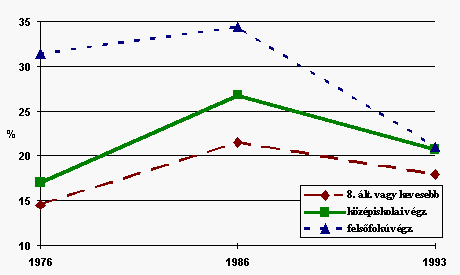
The ratio of fiction read in correlation with educational attainment
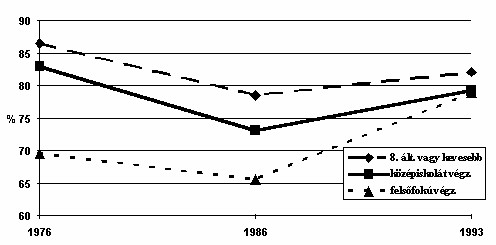
Educational attainment influences the reading of non-fiction works. Among those having accomplished 8 or less classes in elementary school this ratio was 14.5 % in 1976, 21.4 % in 1986, 17.9 % in 1993. The ratio of those reading non-fiction is lower among them than among the entire population, except for the last survey. As regards the graduates of secondary schools, the ratio of non-fiction is 17, 26.8 and 20.7 % at the times mentioned.
Among the reading materials of the graduates of higher education non-fiction, i.e. professional and scientific works is to be found in a higher ratio, 31.4 % in 1976, a little more than one third in 1986, and a mere one fifth in 1993. It is noteworthy that those with different educational attainment have come to a similar level by 1993, the differences have almost ceased, the trend of homogenisation being very striking.
Fiction is even more dominating in the reading structure of women. In 1976 fiction made up hardly more than one tenth of their reading materials, in 1986 - one fifth and in 1993 - 16.7%, including books providing guidance on raising children, in matters of marriage and divorce, and everyday activities such as cooking, knitting and crocheting, and taking care of indoor plants. In 1976 several interviewees reported reading the book entitled "From the awakening of love to harmony" (author: Attila Bágyoni), in 1993 two interviewees read the biographical novel entitled "Piles" (author: Gyula Horn) on the day of investigation.
Among the reading materials of men in 1976 the ratio of special and non-fiction literature is 22.1%, i.e. twice as much as with women, in 1986 one third of their reading materials, while merely one fifth in 1993. The books mentioned include tools of building a house, household farming, various hobbies and learning, but the book by Glasenapp: Die fünf Weltreligionen was also among their reading materials. In 1993 five interviewees reported reading Churchill's book entitled The Second World War on the day of investigation.
In 1993 the interview dealt with the book just being read on the day of investigation. The Bible was mentioned 65 times, that was classified into non-fiction during coding - in my view in a disputable manner. Praybooks were mentioned by 11 interviewees, the Picture Bible by two persons. The book by Moody: Life after life was mentioned twice. Scattering is rather substantial. We can, however, state that most of the non-fiction books read in 1993 are related to religion (the authors are Gellért Belon, István Kamarás, Bubola, Woodrow, Rosa).
As regards the types of settlements we find rather substantial differences, except for the last survey in 1993. In the villages the ratio of non-fiction books is 12.1, 20.9 and 18.4 % respectively, in the rural towns - 20.2, 26.7, 18.2 %, in Budapest - 19, 29, 17 %. In 1986 the ratio of non-fiction was considerably higher. In the capital at this time by almost 10 % more fiction is read than in the villages. By 1993 homogenisation is also apparent here. It is interesting to note that in 1993 the ratio of non-fiction is by almost 10 % higher among the reading materials of 60-79-year-olds than among those of younger age groups.
What can be concluded from the above figures? Non-fiction works are used for learning, work, orientation in everyday life. Fiction raises from the troubles of life, one can escape from everyday life, can build an imaginary world.
During the Finnish-Hungarian reading research of 1986-1987 it was found that while non-fiction constitutes 1/3 of the reading materials of the Finnish, the same figure is merely 1/4 with the Hungarians. The Finnish have moved towards instrumentalist reading, while the Hungarian reading mentality is of rather expressive nature, and this trend has stepped up by 1993 (Lőrincz, J. - Vakkari, P.: 1991.).
Naturally, substantial changes have occurred in the structure of publishing, i.e. the "product structure" during the twenty years being the subject of our analysis. In the 80s the ratio of documentary literature has increased. In addition to scientific works on esoteric, parapsychologic subjects have appeared, but the most striking change implied that entertaining works, light reading have flooded the streets, the one-time "forbidden fruits" have come to the market, the dumping of thrillers, action novels and science fiction works has not left the mentality of readers unchanged.
The mild growth of non-fiction in the publishing structure has not considerably increased the reading of the works concerned. We shall come back to the entertaining works later. Reading is not an isolated practice, is part of the real way of life and develops within the general framework of taste. In the West the novel has gone through a slow process of declassing, while documentary literature has gained ground, and the reading of non-fiction has become a necessity. The ratio of these works has somewhat increased on the list of works published in Hungary, and their reading has somewhat increased during the 80s, but according to data from 1993 their popularity has not grown simultaneously with their presence. Orientation in the world, mobility in society slowly starts to demand non-fiction books as tools, although the transformation of the economic and social structure, the requirement of knowledge arising in various fields of life should mean a challenge. The non-fiction works published in the 90s are demanding from the point of their external look, they are printed in colour, contain many illustrations, are spectacular. This high-standard book-type based on visuality is expensive, is almost unpayable for those living from wages and salaries. We may be right to suspect also obstacles regarding approach, in addition to financial limitations. The relatively low demand for acquiring knowledge, the weak inclination to face facts may show a correlation with the slow pace of modernization and democratization.
We should of course take into account that new technology, reading from the screen complement the information originating from books, and Internet also plays a role, but their presence in Hungarian households is not so significant that they would push non-fiction works to the background.
As regards authors, in the time-budget analysis of 1962 by the Central Statistical Office their list is headed by Jókai, Móricz, Mikszáth, Gárdonyi. I have to add that in 1962 hardly any light reading was published on the Hungarian book market.
What is the composition of the works read based on the three surveys made during the last 20 years, if we consider the time of writing? We read strikingly less works from the 19th century now than 20 years ago. In 1976 books from the last century and from the early years of our century made up 29 % of reading materials, the same figure being 15 and 9 % in 1986 and 1993 respectively. The attractive force of the last century has considerably decreased, especially if we recollect that the list of favourite authors started in the 60s as follows: Jókai, Mikszáth, Gárdonyi.
In 1993 altogether 29 interviewees mentioned Mór Jókai (including all the books by Jókai read on the day of investigation). Tolstoi is present with 4, Kálmán Mikszáth with 5, Stendhal with 4 mentions.
Contemporary works made up 10 % of reading materials in 1976 according to the survey of the Central Statistical Office. In 1986 already 31 %, in 1993 more than half of the reading materials contained works that have been recently written. These data could cover the heartening fact that our reading structure is modern, we keep pace with our age, we receive the latest, demanding answers to our demanding questions, our reading materials help us see the problems evolving in our life. If we proceed further and take into account that a substantial percentage of works belong to light reading and the increase of low-standard works is considerable, our self-conscience is not justified.
Let us have a look at distribution by style!
Distribution of books read, by style, in the total population aged 18-69
1976
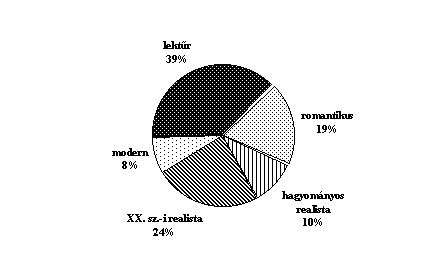
1986
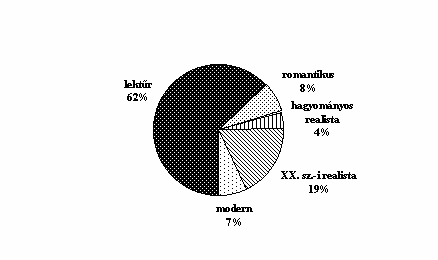
1993
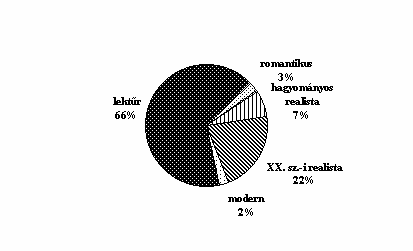
Women read by 12 % more light reading materials than men. If we consider here also the type of settlement, we find that in rural towns light reading materials make up almost 3/4 of all reading materials (71.2 %). Higher educational attainment and a taste oriented towards more definite values is in some way a limitation to that reading materials be dominated by light reading materials and popular novels. In the reading structure of those with higher education entertaining reading materials are less by 20 %. Let us compare the first ten books in the ranklist of the frequency of reading in 1976 and 1993, in a decreasing order of mentions.
|
1976 |
1993 |
||
|
all mentions: 1087 |
mentions |
all mentions: 1274 |
mentions |
|
author, title |
author, title |
||
| Kerouac, J.: On the road |
16 |
Bible |
65 |
| Remarque, E. M.: Zeit zu leben und Zeit zu sterben |
16 |
Mitchell, M.: Gone with the wind |
18 |
| Garcia Marquez, G.: Cien anos de soledad |
14 |
Cook, R.: Blindsight |
11 |
| Hemingway, E.: For whom the bell tolls |
14 |
Praybook |
11 |
| Knight, E.: This above all |
13 |
Julia books |
8 |
| Sienkiewicz: Quo vadis |
11 |
Romana books |
7 |
| Shaw, I.: The young lions |
10 |
Steel, D.: Remembrance |
6 |
| Bible |
9 |
Follet, K.: Pillars of the earth |
6 |
| Merle, R.: Les hommes proteges |
9 |
King, S.: Pet cemetary |
6 |
| Soldati, M.: La sposa americana |
9 |
Churchill, W.: The Second World War |
6 |
Distribution of books by the nationality and geographical origin of the author
|
1976 |
1986 |
1993 |
|
| Hungarian |
49,9 |
45,6 |
31,3 |
| Russian and the countries of the former Soviet Union |
5,4 |
3,0 |
1,7 |
| Central and Eastern European |
2,7 |
3,6 |
1,4 |
| Western European |
27,9 |
26,1 |
33,5 |
| American (North, Central and South together) |
12,6 |
17,6 |
30 |
| other |
1,3 |
3,9 |
0,4 |
| non-applicable |
0,2 |
0,2 |
1,6 |
From among Russian authors in 1993 Tolstoi, Solzhenitsyn, Pasternak, Efremov, Bulichov, Tchekhov, Semionov and Bulgakhov have been mentioned.
Central and South America were represented in the Hungarian reading structure in 1993 by Mitchell, Garcia Marquez, Korda, Amado Allende, while North America by 118 authors and 265 mentions. The first eight authors in the ranklist (closing with 5 mentions) were: Steel, D. (46) Crossings and Season of Passion being the most frequently read books, Cook, R. (31), King, St. (13), Riplay, A. (8), Blake, J. (5), Uris, L. (5), Shaw, I. (5).
Who were the most frequently read authors in 1993
|
all mentions |
number of mentions |
percentage |
|
author |
1280 |
100 % |
| 1. Steel, Danielle |
46 |
3,6 |
| 2. Cook, Robin |
31 |
2,4 |
| 3. Jókai Mór |
29 |
2,3 |
| 4. Kenneth, Claire |
22 |
1,7 |
| 5. Szilvási Lajos |
22 |
1,7 |
| 6. Mitchell, M. |
18 |
1,4 |
| 7. Smith, Wilbour |
17 |
1,3 |
| 8. Lawrence, Leslie L. |
17 |
1,3 |
| 9. Follett, Ken |
14 |
1,1 |
| 10. Marsh, Evelyn |
13 |
1 |
Jókai is preceded by Steel and Cook. Among women the light readings by Kenneth are extremely popular: Randevú Rómában, Minden tavasz véget ér, Holdfény Kairóban, Halálos háromszög, Dupla martini, A hermelines hölgy. From among the books by Leslie Lawrence Sindzse szeme, Keselyűk gyászzenéje, A gonosz és a fekete hercegnő were very frequently in circulation.
The ratio of light reading materials in correlation with educational attainment
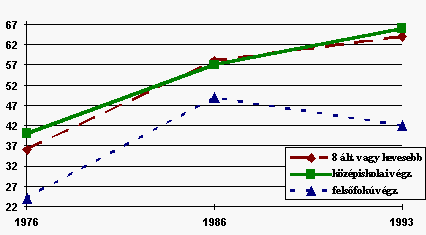
The strict literature of high standard, facing the problems of life, searching for the reasons of existence, increasing personal conscience may be interesting today for a few people only. I refer to the words of the Hungarian poet Mihály Babits: "the feeling of values is lost here, the covers as colour envelops are crying loudly and the cry of one suppresses the other, the process of literature is speeding up, it becomes almost as quick as that of journalism, where the news of the morning become obsolete by evening and become "historic relics", literature is not a collection of quiet treasures any more, no island and no refuge, but a uniform, unended procession of the fragments of our age floating on the river..." (Babits M. 1933, 89. p.)
Let us come back to the nationality of authors. In 1976 half of the authors were Hungarian and we know that classical realistic and romantic works are dominating. Today Hungarian authors make up not even 1/3 of the reading structure (31.1 %). The ratio of Western European authors is most balanced in the time rows, changes between 26 and 30 % in the last 20 years. The ratio of American authors has increased from 12 % to 30 % in the reading structure of the Hungarian population.
Writing and reading have a dual role, being a communication tool on the one hand, and as such, being a knowledge tool as well as a power tool on the other. Meaning, the comprehension of meaning operates relying on power logic, using Bourdieu's expression: writing acts as a symbolic capital through the mechanisms of exclusion and inclusion. Frequent and attractive reading materials, as we could see, do not belong to the high-class art. Mass demand and taste affects the book market, the intellectual performance exposed to the marketing mechanism of the capital operating on the cultural market. Mass culture changes specific experience into cultural experience constants and thus ensures the ease of acquiring without any resistance (Király J. 1981). Adventure, thrillers, light reading may address anyone, the activity themes included in them act as evident and stereotypes assume a role.
Criminal novels, adventure novels and their today's version, the action novel, science fiction and thrillers signify a "wide spectrum" of mass-published entertaining paperback books. Even though these books are not cheap either, they are relatively accessible. Love romance, brochure novels, mystic ghost stories operating with blood wolves, vampires, robbery, murder, sharing treasures, physical violence are offering themselves all over. They amplify the similar programmes of this type broadcast by television. They do not contribute to our awareness of our situation, to formulating our life objectives, to forming and realizing our dreams to follow.
Culture has a role to create continuity, traditions form a system of correlations even if there is a contradiction between the elements. Such an intensive presence of popular novels in the reading structure questions the traditional value system, marks a counter-world to that and creates a confusion regarding the possibility of comprehension in each for the other one.
Behind the spreading of subliterature and its reading level, the popularity of television programmes of this type there is an integration process going on. Using Baudrillard's expression: the smallest common culture assumes leadership. Consumers are being urged and conditioned by advertisements in the field of objects and correlations. Instead of high-level literature, theatre, in-depth talks with parents and teachers you are attracted by horror, advertisements, crime stories, a series of aggressive actions or the simplified world of cartoons.
Can these contribute to the betterment of the way of life, to the humanization of living conditions and to the better delineation of roles in life? In no way. They mediate a poorer world, free from values and sensitive to appearances; they raise an illusion of free choice, as the schemes are the same.
![]()
1A tanulmány alapjául az OTKA által támogatott T17835 sz. kutatás szolgált. A kutatást Falussy Béla vezette.
![]()
Babits M.: A nyugat költője 3. Nyugat in: Írók a két háború közt 89-95 p. (The poet of the West. Authors between the two wars; in Hungarian)
Falussy B..: A jövedelemszerző munka és a szabadidő felhasználás változásai, rétegkülönbségei - hazai és külföldi időmérlegek alapján. Budapest, 1996. KSH (Changes and differences by strata in money-earning work and the utilization of free time, based on time budgets from Hungary and abroad; in Hungarian)
Falussy B.: Média az idő mérlegén = Jel-Kép 1997/3. no. 27-55.p. (Media - a time balance; in Hungarian)
Hankiss E. - Marchin F. - Füstös L. - Szakolczay Á.: Kényszerpályán? A magyar társadalom értékrendszerének alakulása 1930 és 1980 között. Kiad.: MTA Szociológiai Intézet 1982. I. vol. 240. p. II. vol. 478.p. (Evolution of the values system of Hungarian society between 1930 and 1980; in Hungarian)
Király J.: A szórakozás = Kultúra és közösség 1981/1. no. 3-28. p. (Entertainment; in Hungarian)
Laki L.: Magyar fejlődés sajátszerűségének néhány vonása = Szociológiai Szemle 1997/3. no. 67-91. p. (Some features of the peculiarities of Hungarian development; in Hungarian)
Lőrincz J.: Changes in the booktrade and publishing in Hungary 1985-1994 = International Information and Library Review 1995, 27. 59-67. p.
Lőrincz J. - Vakkari, P.: Távoli rokonok - közeli barátok. Magyarok és finnek az olvasásszociológia tükrében. Budapest, 1991. Publ.: OSZK 110 p. (Distant relatives - close friends. Hungarians and Finns as reflected by reading sociology; in Hungarian)
![]()